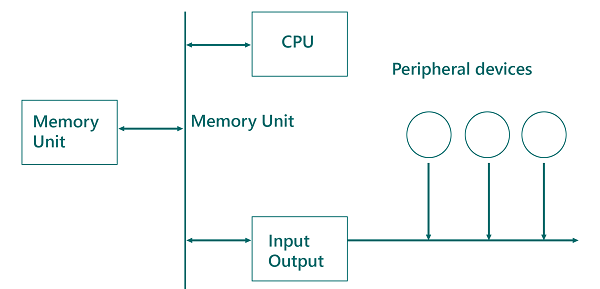Home »
Computer Science Organization
Input Output Management in Computer Organization
In this article, we are going to discuss the input-output management and the different types of buses that are used in performing the various operation in computer organizations.
Submitted by Prerana Jain, on August 10, 2020
Introduction of Input-Output Management
- In general, when we say a computer, we understand a CPU + memory (cache main memory).
- But a computer does not serve any purpose if it cannot receive data from the outside world or cannot transmit data to the outside world.
- Input and output or peripheral devices are those independent devices that serve this purpose.
- So, while designing input and output for a computer we must know the no. of input and output device and the capacity of each device
Interface
We cannot directory connect an input and output device to computer hierarchy because of the following reason,
- Speed: The speed of the CPU and input and output device will usually different.
- Format: The data code and format of CPU and generate peripheral may be different eg. ASCIL Unicode.
- Physical orientation: Different devices have organizations like optical, magnetic, electrochemical, and different controlling functions.
- Signal conversion: Peripheral are electromagnetic and electrochemical device and their manner of operation is different from the option of CPU and memory which are an electronic device, the signal conversion is required.
- Address bus: It is used to identify the correct input and output device among the number of input and output device, so CPU put an address of a specific input and output device on the address line all device keep monitoring this address bus and decode it and if it a match then it activates control and data lines.
- Control bus: After selecting a specific input and output device CPU sends a functional code on the control line. The selected device (interface) reads that functional code and execute if eg. Input and output command, control command, status command, etc.
- Data bus: In the final step depending on the operation either CPU will put data on the data line and the device will store it or device will put data on the data line and CPU will store it.
Memory Mapped Input and Output
- Here there are no separate input and output instructions. The CPU can manipulate input and output data residing in the interface register with the same instructions that are used to manipulate memory words.
- Here computers can use memory type instruct for input and output data.
Example: 8085
Advantages
In a typical computer, there is more memory reference instruction than input and output instruction, but in memory-mapped input and output all instruction that refers to memory is also available for input and output.
Disadvantages
Total address gets divided, some range in occupied by input and output while some memory.
Isolated Input and Output
- Here the common bus to transfer data between memory or input and output and CPU. The distinction between memory and input and output transfer is made through a separate read and write the line.
- Input and output read and input and output write control lines are enabled during an input and output transfer.
- Memory read and memory write control lines are enabled during a memory transfer.
Advantages
Here memory is used efficiently as the same address can be used two times.
Example: 8085
Disadvantages
Need different control lines one for memory and others for input and output devices.
Input and Output Processor
- The computer has an independent set of data address and control buses, one for accessing memory and the other. For input and output, this is done in a computer that provides separate input and output processor other than CPU.
- Memory communication with both the CPU and l/O through a memory bus.
- Input-output communicate also with the input and output device through a separate input and output bus with its own address, data, and control lines. The purpose of input-output is to provide an independent pathway for the transfer of information between external devices and internal devices.

Advertisement
Advertisement